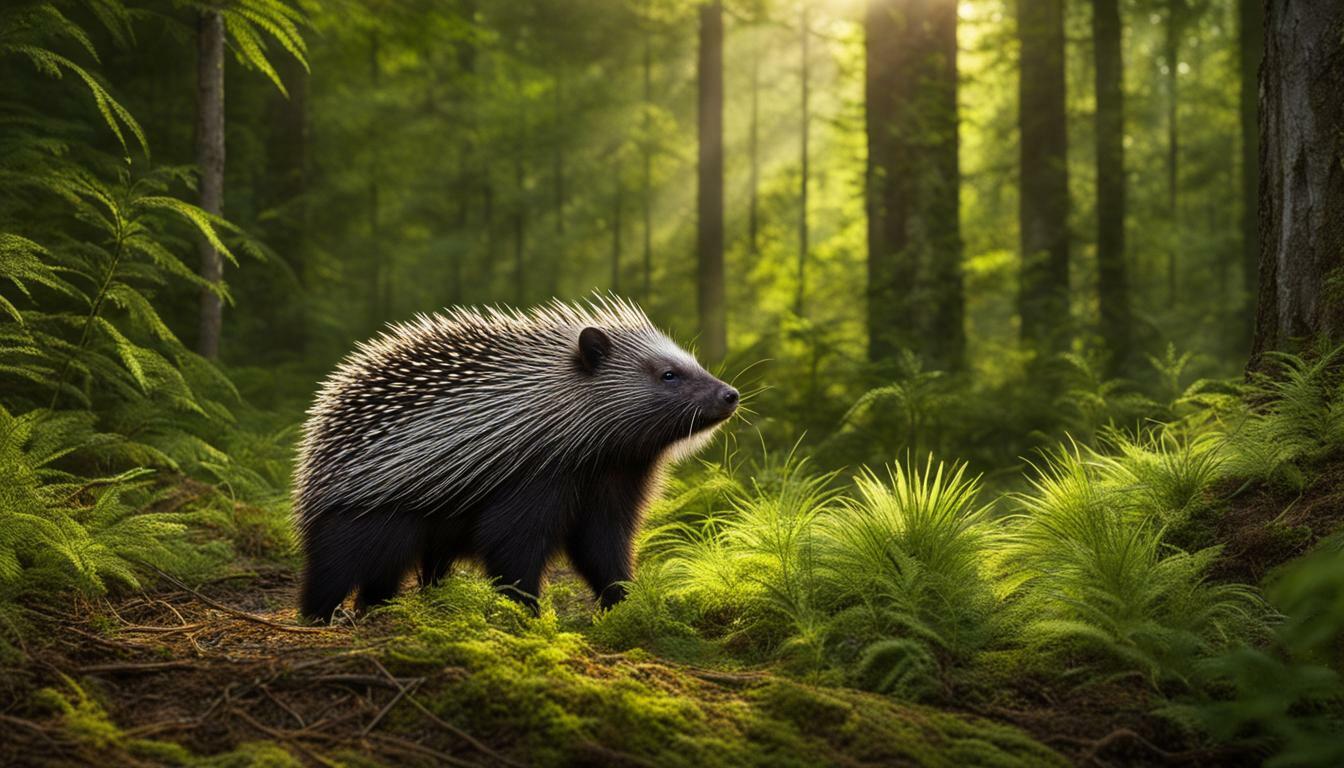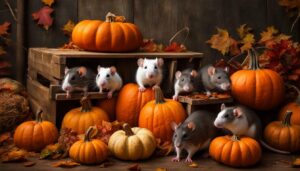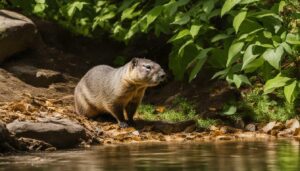North Carolina is known for its diverse wildlife, but are porcupines among the native species found in the state? While some historical evidence suggests the presence of porcupines in the mountainous areas of North Carolina, there is no conclusive proof of their current existence. Recent sightings or specimens are scarce, and further research is needed to confirm the porcupine population in the state.
Key Takeaways:
- There is no conclusive evidence of porcupines in North Carolina.
- Historical records indicate their presence in the mountainous regions of the state.
- No recent sightings or specimens confirm their current existence.
- Porcupines can be found in neighboring states like Tennessee and Virginia.
- While porcupines can be kept as pets, they are not recommended due to their spikes and potential for injury.
- Porcupines primarily eat bark, wildflowers, acorns, roots, and seeds.
Exploring North Carolina’s Wildlife Diversity
North Carolina boasts a wide array of wildlife, with various species calling the state home. From the majestic Black Bears and White-tailed Deer to the elusive Red Wolves and Bobcats, the state offers a diverse range of habitats that support a rich and vibrant ecosystem. North Carolina’s wildlife diversity is a testament to the state’s commitment to conservation and preservation of its natural heritage.
The coastal plains of North Carolina are teeming with life, with unique species such as the American Alligator, Diamondback Terrapin, and Clapper Rail thriving in the marshes and estuaries. These coastal habitats provide essential breeding grounds and feeding areas for a multitude of bird species, including the magnificent Bald Eagle and the endangered Red-cockaded Woodpecker.
| Coastal Plains | Piedmont | Mountains |
|---|---|---|
| American Alligator | White-tailed Deer | Black Bear |
| Diamondback Terrapin | Eastern Box Turtle | Red Wolf |
| Clapper Rail | Northern Cardinal | Bobcat |
In the Piedmont region, which encompasses the central part of the state, you can find an abundance of wildlife. Here, species like the Eastern Box Turtle, Northern Cardinal, and White-tailed Deer thrive in the deciduous forests and open grasslands. This region also provides nesting sites for a variety of bird species, including the vividly colored Eastern Bluebird and the charming Carolina Chickadee.
As you venture into the mountainous areas of North Carolina, you will encounter a completely different ecosystem. The dense forests and rugged terrain are home to iconic creatures like the Black Bear, Red Wolf, and Bobcat. The state’s mountain region also offers a haven for bird-watchers, with sightings of the majestic Peregrine Falcon and the elusive Golden-winged Warbler being a true delight for nature enthusiasts.
North Carolina’s wildlife diversity is a testament to the state’s commitment to preserving its natural resources and protecting native species. With a vast array of habitats, from coastal marshes to mountainous forests, the state continues to provide a home for a wide range of fascinating animals. Whether you’re exploring the coastal plains, the Piedmont region, or the mountainous areas, you’re sure to encounter North Carolina’s incredible wildlife.
References:
- “North Carolina Wildlife Profiles” – North Carolina Wildlife Resources Commission
- “The Natural Heritage Program: North Carolina Wildlife” – North Carolina Department of Natural and Cultural Resources
The Habitat of North Carolina’s Porcupines
Porcupines, like many other animals, have specific habitat preferences that determine their distribution in North Carolina. These unique creatures are well adapted to live in a variety of environments, from forests and woodlands to grasslands and shrublands.
One of the key factors influencing porcupine habitat is the availability of trees, as they rely on them for food and shelter. Porcupines are expert climbers and are often found in areas with abundant trees, such as coniferous forests and mixed hardwood forests. These habitats provide them with a plentiful supply of their preferred food sources, including bark, twigs, and young shoots.
Additionally, porcupines are capable swimmers and can be found in wetland areas, such as marshes and swampy regions. These habitats offer them access to water as well as a diverse range of vegetation to feed on. While porcupines are adaptable and can survive in various habitat types, they generally prefer areas with a good combination of food, water, and shelter.
| Habitat Preference | Examples |
|---|---|
| Forests | Coniferous forests, mixed hardwood forests |
| Wetlands | Marshes, swamps |
| Grasslands | Prairies, meadows |
| Shrublands | Sagebrush, chaparral |
While porcupines have been historically documented in the mountainous areas of North Carolina, their current distribution in the state remains uncertain. There have been no recent sightings or specimens, raising questions about whether they still exist in North Carolina today. However, neighboring states like Tennessee and Virginia do have populations of porcupines, suggesting that they could potentially be found in North Carolina as well.
Understanding the habitat preferences of porcupines is crucial for wildlife conservation efforts in North Carolina. By identifying and protecting their preferred habitats, we can help ensure the survival and well-being of these fascinating native species.
The Distribution of Porcupines in North Carolina
While some historical records indicate the presence of porcupines in North Carolina, it is important to consider their distribution within the state today. Recent sightings and specimens are lacking, making it difficult to confirm their current existence. However, neighboring states such as Tennessee and Virginia have reported porcupine populations, suggesting the possibility of their presence in North Carolina.
Porcupines are known to inhabit mountainous regions, which could explain their historical presence in the state. The rugged terrain and dense forests offer favorable habitats for these elusive creatures. However, without recent observations or verifiable evidence, the true extent of their distribution remains uncertain.
It is worth noting that porcupines are not typically recommended as pets. Their unique defense mechanism of quills, which are sharp and can cause injury, makes them challenging to handle. Additionally, their specialized dietary requirements and habitat preferences make them better suited for life in the wild.
| Porcupine Distribution in North Carolina | North Carolina Animal Species |
|---|---|
| Historical records suggest their presence, but no recent sightings or specimens to confirm current existence | A diverse range of animal species call North Carolina home, including mammals, birds, reptiles, and amphibians |
| Possible distribution in mountainous regions with dense forests | North Carolina’s diverse ecosystems provide habitats for a variety of animal species |
| Neighboring states like Tennessee and Virginia have reported porcupine populations | Conservation efforts are in place to protect the native species in North Carolina |
Porcupines are primarily herbivorous, with a diet consisting of bark, wildflowers, acorns, roots, and seeds. These dietary preferences are well-suited to their survival in forested environments, where they can find ample sources of food. However, due to the lack of recent data, the specific areas within North Carolina where porcupines may be found are uncertain.
In conclusion, while there is historical evidence suggesting the presence of porcupines in North Carolina, their distribution within the state today remains uncertain. Further research and documented observations are needed to confirm the current existence and locations of porcupine populations. It is important to consider the lack of recent sightings or specimens when assessing their presence in the state.
Porcupines in Neighboring States
While porcupines may not be commonly found in North Carolina, neighboring states have documented populations of these spiky creatures. Tennessee and Virginia, in particular, are known to have porcupines inhabiting their forests and wooded areas.
Porcupines are fascinating animals with their quill-covered bodies, and they play an important role in their respective ecosystems. These herbivorous creatures primarily feed on bark, wildflowers, acorns, roots, and seeds, adapting well to a variety of environments.
It is worth noting that while some historical evidence suggests the presence of porcupines in the mountainous areas of North Carolina, there have been no recent sightings or specimens to confirm their continued existence in the state. This absence has resulted in a certain mystery surrounding the presence or absence of porcupines in North Carolina.
| State | Porcupine Population |
|---|---|
| Tennessee | Stable population in various regions |
| Virginia | Populations found in forested areas |
While the exact reasons behind the absence of porcupines in North Carolina remain uncertain, their potential existence in neighboring states sheds light on their adaptability and ability to thrive in similar habitats. As conservation efforts continue to protect and support native species in North Carolina, it is possible that future research may uncover more information about the presence of porcupines in the state.
The Mystery of Porcupines in North Carolina
Despite sporadic mentions of porcupines in North Carolina’s past, their current existence in the state remains a subject of intrigue. Historical evidence suggests that these prickly creatures may have once inhabited the mountainous regions of North Carolina. However, the lack of recent sightings or specimens makes it difficult to conclusively determine whether porcupines still reside in the state.
While neighboring states such as Tennessee and Virginia are known to have porcupine populations, the question of whether porcupines exist in North Carolina remains unanswered. Wildlife enthusiasts and researchers continue to explore the possibility of porcupine presence in the state, but as of now, there is no concrete evidence to confirm their existence.
It is important to note that porcupines, with their quills instead of hair, possess a unique defense mechanism. Although some individuals may be tempted to keep them as pets, it is generally not recommended. Porcupines require specialized care and handling due to their sharp quills, which can cause injury to humans if not properly managed.
Porcupines are known to have a varied diet, consisting mainly of bark, wildflowers, acorns, roots, and seeds. Their feeding habits are adapted to their environment, and they are capable of surviving in different types of habitats, including forests, woodlands, and even grasslands.
| Porcupine Facts | |
|---|---|
| Scientific Name: | Erethizon dorsatum |
| Native Range: | North America |
| Habitat: | Forests, woodlands, grasslands |
| Main Diet: | Bark, wildflowers, acorns, roots, seeds |
| Special Feature: | Defensive quills |
Keeping Porcupines as Pets
While porcupines may intrigue some as potential pets, their unique physical characteristics and care requirements make them challenging companions. Porcupines are known for their quills, which are sharp spines that cover their bodies as a defense mechanism. These quills can cause injury to both humans and other animals, making porcupines unsuitable for households with children or other pets.
Additionally, porcupines have specific dietary needs that can be difficult to meet in a domestic setting. They primarily eat bark, wildflowers, acorns, roots, and seeds, which may not be readily available in a home environment. Providing a varied and nutritionally balanced diet for a pet porcupine can be a complex task.
Porcupines also require ample space and enrichment opportunities to mimic their natural habitat. They are adept climbers and need vertical space to explore and satisfy their curiosity. Creating a suitable enclosure that meets their physical and behavioral needs can be challenging and expensive.
| Challenges of Keeping Porcupines as Pets | Reasons |
|---|---|
| Quill injuries | Porcupines have sharp quills that can cause harm to both humans and other animals. |
| Specialized diet | Porcupines require a diet consisting of bark, wildflowers, acorns, roots, and seeds, which can be challenging to provide in a domestic setting. |
| Space requirements | Porcupines need ample space and vertical structures for climbing and exploration. |
Considering these factors, it is generally recommended to appreciate porcupines in their natural habitat rather than attempting to keep them as pets. By observing these fascinating creatures from a safe distance, we can ensure their well-being and contribute to the conservation efforts aimed at protecting native species in North Carolina.
Porcupine Diet and Feeding Habits
Porcupines have distinct dietary preferences, feeding on a variety of plant matter found in their habitat. Their diet primarily consists of bark, wildflowers, acorns, roots, and seeds. These spiky creatures are well-adapted to their feeding habits, using their sharp and strong incisors to chew through the tough outer layers of tree bark to access the tender inner layers.
One interesting adaptation of porcupines is their ability to climb trees to reach their preferred food sources. They are known to be particularly fond of the bark of certain tree species, which provides them with essential nutrients and sustenance. Their ability to feed on a diverse range of plant matter allows them to thrive in various habitats, including forests, woodlands, and even grassy areas with abundant vegetation.
Porcupines are considered herbivores, solely relying on plant-based food sources to meet their nutritional needs. Their feeding habits play a crucial role in shaping the ecosystems they inhabit, as they contribute to the dispersal of seeds through their consumption of various fruits and nuts.
| Porcupine Diet | Feeding Habits |
|---|---|
| Bark | Porcupines chew through tree bark to access the inner layers. |
| Wildflowers | Porcupines consume a variety of wildflowers found in their habitat. |
| Acorns | Acorns are a favorite food source for porcupines. |
| Roots | Porcupines feed on roots, utilizing their strong teeth to dig and extract them from the ground. |
| Seeds | Porcupines consume various types of seeds, contributing to seed dispersal in their habitat. |
North Carolina Wildlife Conservation Efforts
North Carolina is committed to preserving its rich wildlife diversity through various conservation initiatives. The state recognizes the importance of protecting its native species and the unique ecosystems that support them. These efforts aim to ensure the long-term survival of North Carolina’s diverse wildlife populations for future generations to enjoy and appreciate.
Conservation Programs
To safeguard the native species in North Carolina, the state has implemented several conservation programs. These programs focus on habitat restoration, species monitoring, and public education. By restoring and preserving natural habitats, conservationists create safe spaces for wildlife to thrive. Monitoring initiatives help assess the health and population trends of various species, allowing for informed conservation decisions. Public education efforts raise awareness about wildlife conservation and promote responsible actions to protect native species.
Collaboration and Partnerships
Conservation efforts in North Carolina are made possible through collaboration and partnerships between government agencies, nonprofits, and local communities. These stakeholders work together to develop strategies, share resources, and implement conservation projects. Through these collaborative efforts, North Carolina can maximize the impact of its conservation initiatives and ensure a more sustainable future for its wildlife.
A Bright Future for North Carolina’s Wildlife
North Carolina’s commitment to preserving its wildlife diversity sets a positive course for the future. By prioritizing conservation efforts and engaging with communities, the state can continue to protect its native species and promote the importance of preserving biodiversity. Through ongoing dedication and collective action, North Carolina will play a vital role in conserving its unique wildlife for generations to come.
| Conservation Programs | Collaboration and Partnerships | A Bright Future for North Carolina’s Wildlife |
|---|---|---|
| Habitat restoration | Government agencies | Preserving native species |
| Species monitoring | Nonprofits | Promoting biodiversity |
| Public education | Local communities | Sustainable future |
Discovering North Carolina’s Fascinating Native Species
North Carolina is home to a plethora of native species, each with its own intriguing characteristics. From the majestic black bear to the colorful indigo snake, the state’s diverse wildlife never fails to captivate nature enthusiasts. The coastal areas boast an abundance of sea turtles, including loggerheads and green turtles, which return every year to lay their eggs on sandy beaches.
In the mountainous regions of North Carolina, the elusive and endangered Carolina northern flying squirrel can be found. This nocturnal creature is known for its ability to glide effortlessly between trees. Another unique native species is the red wolf, a critically endangered canid species that once roamed freely throughout the Southeast.
North Carolina’s vast forests and wetlands provide habitat for a variety of bird species, including the prothonotary warbler and the American woodcock. These birds, among many others, rely on the state’s diverse ecosystems for nesting and foraging. Wetlands, in particular, are important breeding grounds for amphibians such as the salamander and the rare Hellbender.
The Importance of Wildlife Conservation
Preserving North Carolina’s native species and their habitats is crucial for maintaining the state’s rich biodiversity. Conservation efforts play a vital role in protecting these species from habitat loss, pollution, and climate change. Through educational programs and the establishment of protected areas, organizations and government agencies strive to ensure the survival of these remarkable creatures for future generations.
| Native Species | Habitat | Characteristics |
|---|---|---|
| Black Bear | Forests, Mountains | Largest land mammal in the state, known for its strength and adaptability |
| Carolina Northern Flying Squirrel | Mountainous regions | Nocturnal gliding ability, endangered species |
| Red Wolf | Coastal Plains | Critically endangered canid, once roamed freely throughout the Southeast |
| Prothonotary Warbler | Wetlands, Forests | Bright yellow plumage, migratory bird |
North Carolina’s rich wildlife heritage is a testament to the state’s commitment to conservation. By preserving these native species and protecting their habitats, North Carolina ensures that future generations can continue to marvel at the diverse and fascinating creatures that call this state home.
Exploring North Carolina’s Animal Habitats
North Carolina’s diverse animal habitats provide a range of environments for different species to thrive. From the mountains to the coast, the state offers a variety of ecosystems that support a wide array of wildlife. In these habitats, animals can find the necessary resources for survival, including food, water, and shelter.
In the mountainous regions of North Carolina, dense forests and rocky terrain create suitable habitats for a range of species. The cool climate and ample precipitation support the growth of lush vegetation, providing food and cover for animals such as black bears, bobcats, and deer. The rocky outcrops and cliffs offer shelter to birds of prey, while rivers and streams provide freshwater for fish and amphibians.
As we move towards the coastal areas, a different type of habitat emerges. The salt marshes, dunes, and barrier islands provide a unique environment for various species. Marshes teem with life, attracting birds, fish, and reptiles. The sandy beaches serve as nesting grounds for sea turtles, while the estuaries and wetlands offer a haven for diverse aquatic organisms. Coastal forests are also home to creatures like the red wolf and the elusive eastern diamondback rattlesnake.
Protecting North Carolina’s Animal Habitats
Preserving these animal habitats is crucial for maintaining the state’s biodiversity. Several conservation efforts are in place to safeguard these ecosystems and the species that depend on them. Organizations such as the North Carolina Wildlife Resources Commission work to protect and manage wildlife populations, ensuring that these habitats continue to thrive.
In addition to conservation efforts, public awareness and education play a vital role in preserving these habitats. By understanding the importance of these ecosystems and the species they support, individuals can make informed decisions to help protect and conserve North Carolina’s animal habitats for future generations.
| Mountainous Habitats | Coastal Habitats |
|---|---|
| – Dense forests | – Salt marshes |
| – Rocky terrain | – Dunes |
| – Rivers and streams | – Barrier islands |
| – Cliffs and outcrops | – Estuaries and wetlands |
Conclusion
While there is historical evidence of porcupines in North Carolina, their current presence in the state remains uncertain. According to available sources, there is no conclusive evidence to confirm the existence of porcupines in North Carolina today. Despite some past sightings in the mountainous regions of the state, there have been no recent reports or specimens to support their ongoing presence.
However, neighboring states such as Tennessee and Virginia have reported the presence of porcupines, suggesting that these animals may still inhabit areas surrounding North Carolina. It is possible that porcupines have migrated to these nearby regions from other parts of their natural range.
While porcupines can be kept as pets, their ownership is not recommended due to the unique challenges they present. Unlike most mammals, porcupines have spikes instead of hair, making them capable of inflicting painful injuries. As such, they require specialized care and handling, and their maintenance as pets should only be undertaken by experienced individuals with the necessary knowledge and facilities.
Porcupines are herbivores and primarily feed on bark, wildflowers, acorns, roots, and seeds. They play a unique role in their ecosystems as they help control vegetation growth through their feeding habits. However, their specific niche within the wildlife diversity of North Carolina, if indeed present, remains uncertain.
FAQ
Are there porcupines in North Carolina?
According to the sources, there is no conclusive evidence that porcupines can be found in North Carolina.
Where can porcupines be found in North Carolina?
There are no recent sightings or specimens to confirm their current existence in North Carolina.
Can porcupines be kept as pets?
Yes, porcupines can be kept as pets, but they are not recommended as they have spikes instead of hair and can cause injury.
What do porcupines eat?
Porcupines primarily eat bark, wildflowers, acorns, roots, and seeds.




